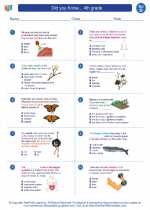Denitrification
Denitrification is a process by which nitrates (NO3-) are converted into nitrogen gas (N2) or nitrous oxide (N2O) by bacteria in the soil. This process is part of the nitrogen cycle and plays a crucial role in returning nitrogen to the atmosphere.
Key Points to Understand
- Denitrification is carried out by specialized bacteria such as Pseudomonas and Paracoccus, which use nitrates as a source of energy.
- This process occurs in anaerobic conditions, meaning in the absence of oxygen.
- Denitrification helps to reduce the accumulation of nitrates in the soil, which can otherwise lead to environmental problems such as water pollution.
- The end products of denitrification are nitrogen gas and nitrous oxide, both of which are important greenhouse gases.
- Human activities such as excessive use of fertilizers and industrial processes can increase the rate of denitrification, leading to environmental concerns.
Study Guide
Here are some key questions and concepts to help you study denitrification:
- What is denitrification and why is it important in the nitrogen cycle?
- Explain the role of bacteria in denitrification and the conditions required for this process to occur.
- Discuss the environmental implications of denitrification and the potential impacts of human activities on this process.
- Compare and contrast denitrification with other processes in the nitrogen cycle, such as nitrogen fixation and nitrification.
- Propose potential strategies to mitigate the negative effects of excessive denitrification on the environment.
By thoroughly understanding the process of denitrification and its implications, you will gain a deeper insight into the complexities of the nitrogen cycle and its significance in environmental science.
.◂Science Worksheets and Study Guides Fourth Grade. Did you Know... 4th grade
Study Guide Did you Know... 4th grade
Did you Know... 4th grade  Worksheet/Answer key
Worksheet/Answer key Did you Know... 4th grade
Did you Know... 4th grade  Worksheet/Answer key
Worksheet/Answer key Did you Know... 4th grade
Did you Know... 4th grade  Worksheet/Answer key
Worksheet/Answer key Did you Know... 4th grade
Did you Know... 4th grade 

 Worksheet/Answer key
Worksheet/Answer key
 Worksheet/Answer key
Worksheet/Answer key
 Worksheet/Answer key
Worksheet/Answer key

The resources above cover the following skills:
Core Ideas for Knowing Science
Life Science
Organisms are organized on a cellular basis and have a finite life span.